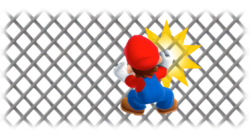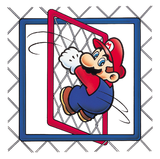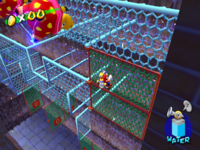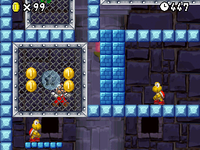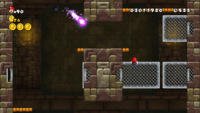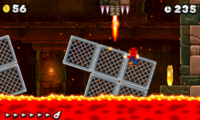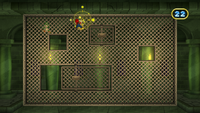Fence
| It has been suggested that Chain-Link be merged with this page. (discuss) |
It has been requested that this article be rewritten and expanded to include more information.
A Fence is an object found in various Mario games. The player character can climb along the surface of the Fence and punch it to defeat enemies on the other side, and to use panels that flip them to the other side. Fences usually appear in 2D platformers such as Super Mario World and New Super Mario Bros., in which can be pressed to cling to them.
History
Super Mario series
Super Mario World
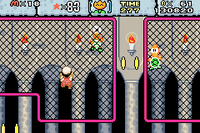
In Super Mario World, Fences occasionally appear in Castles. Mario or Luigi can jump on, climb on, and jump off of them to go around traps like Lava. The brothers can also flip to the other side by punching a square panel. Climbing Koopas are commonly found to be climbing on Fences, and they are capable of climbing around both sides of the fence. The brothers may punch the Climbing Koopas that are on the other side to defeat them.
Super Mario Sunshine
In Super Mario Sunshine, Fences can be used the same way. Many of the fences take the form of boxes which enclose enemies and coins, although some are traditionally flat. Fences appear in Ricco Harbor, Pinna Park and Pianta Village and can be used to knock off enemies from the other side.
New Super Mario Bros.
Fences appear again in New Super Mario Bros. in World 3-![]() Tower and World 4-
Tower and World 4-![]() Tower, being the principal feature of both levels.
Tower, being the principal feature of both levels.
New Super Mario Bros. Wii
Fences reappear in New Super Mario Bros. Wii as obstacles in Towers and Castles, similar to Super Mario World. Certain areas are inaccessible unless the player switch to the other side of the fence, via the revolving gate. There is also a special type of Fence which can be rotated 90 degrees left or right by the first player who climbs the fence by tilting the Wii Remote left or right. Also, a yellow Fence is used in the Power-up Panels minigame.
New Super Mario Bros. 2
Fences also reappear in New Super Mario Bros. 2, along with other special types of Fences introduced in the game. In World 5-![]() Tower, there are large Fences made up of smaller Fences that move upwards along with the rising lava and, at certain points, rotate. They are required to progress through most of the level. In World 5-Castle, there are Fences that move along a wire once the player climbs them, and can be changed to move above or below the wire by pressing
Tower, there are large Fences made up of smaller Fences that move upwards along with the rising lava and, at certain points, rotate. They are required to progress through most of the level. In World 5-Castle, there are Fences that move along a wire once the player climbs them, and can be changed to move above or below the wire by pressing /
. The revolving gates are absent.
New Super Mario Bros. U
Fences appear once again in the Wii U game New Super Mario Bros. U with the same design as in Super Mario World, with red borders instead of gray. Unlike in other games, however, the player cannot punch on the fences. The revolving gates are absent once more.
Super Mario World television series
A small Fence makes a brief appearance as an obstacle in Neon Castle in the Super Mario World animated series episode "Mama Luigi". Mario, Luigi and Yoshi are able to easily pass this gate by simply using its revolving door.
Mario Party 9
In Mario Party 9, a fence appears in the Bowser Jr. minigame, Cage Match. They are used in the same way as in New Super Mario Bros. Wii.
Names in other languages
| Language | Name | Meaning |
|---|---|---|
| Japanese | 金網[1] Kanaami フェンス[2] Fensu |
Wire Netting Fence |
| German | Zaun |
Fence |
| Russian | Сетка Setka |
Fence |
| Spanish | Valla |
Fence |
